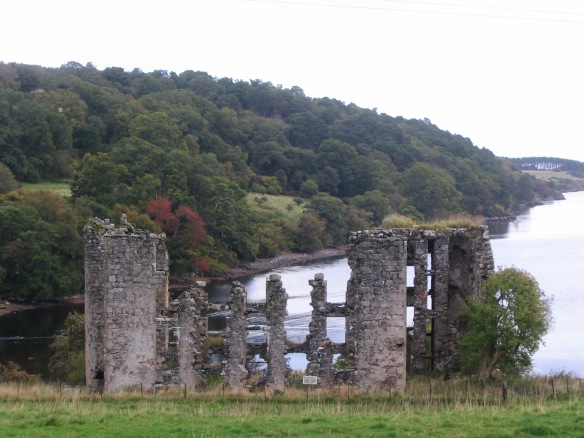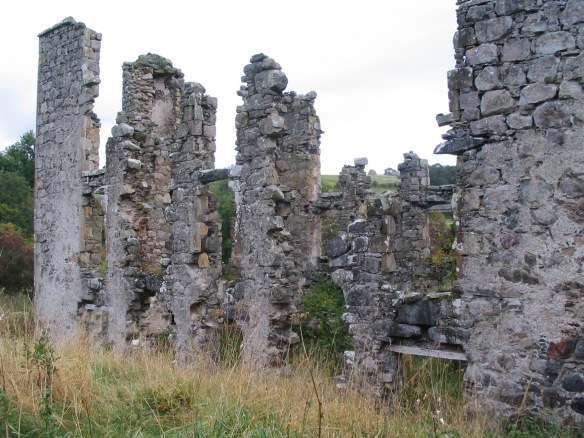Katie Louise McCullough is an historian and the Director of the Centre for Scottish Studies at Simon Fraser University. Her research focuses on the economic and social development of the Highlands and Islands during the Improvement Era. Katie has spent many wonderful trips to Dornoch and the surrounding areas hiking and walking the beautiful countryside with her good pal Elizabeth Ritchie.
In Spinningdale, on the north side of the Dornoch Firth, stand the remnants of a cotton mill. It was built from 1792-4 by the Balnoe Company for the agriculturalist and politician George Dempster, Esq. of Dunnichen (1732-1818), owner of the Skibo estate, and his Glasgow partner David Dale. The men raised over £3000 for the mill, largely from Glasgow businessmen. It was part of a broader plan for social and economic development in the Highlands and Islands of Scotland that championed the provision of employment and poverty relief rather than clearance and turning over land to sheep walks.

Photo from collection of Elizabeth Ritchie
As an MP Dempster had a reputation for incorruptibility, gaining him the sobriquet of ‘Honest’ George. He brought his honesty and hard work to his development interests. Dempster was part of a network of improvers centred on the Highland Society of London (est. 1778) and its sister society the Highland Society of Scotland (est. 1784). Key players in these societies formed a subsidiary company the British Fisheries Society (Dempster was a director of the HSS and BFS) in 1786. In order to provide employment, the BFS established planned fishing villages in the western Highlands and Islands, an area noted by these men for its “underdevelopment.” Colleagues found within these networks blamed slow economic development and poverty on the Whiggish improvers of the early- and mid-eighteenth century who blamed Highlanders for their own poverty. In contrast, Dempster and like-minded friends felt the solution was not in raising great numbers of sheep but, as Sir John Sinclair argued, “by the introduction of arts and agriculture. The first will increase the number and wealth of the people; the latter will augment the quantity of the production of the soil, both for the maintenance of people and cattle. But neither arts nor agriculture can prosper, unless the inhabitants are secure in the tenure, by which they occupy the spots on which they live.” And so, Dempster and his colleagues came up with plans to build homes and transportation links, provide suitable local employment, and reduce or freeze rents until people got on their feet.
The Spinningdale mill was intended to provide employment for people from the nearby parish of Criech and its environs, including the Pulrossie estate, owned by Dempster’s brother. Local people lived off the sale of cattle and grew some potatoes and corn. Some considered this to be “hardly sufficient to maintain the families of the tenants,” resulting in difficulty paying rent and outmigration. Young men and women often temporarily migrated to the south: some “got high wages, and returned in winter to their parents, or relations, somewhat in the stile [sic] of gentlemen, and were a burden on their friends the whole winter, until they set out again in spring.” Some did not return; possibly marrying, dying, emigrating, or being “picked up by recruitment parties.”

Photo from collection of Elizabeth Ritchie
Emulating the fishing villages built by the BFS in the 1780s (Ullapool, Stein, and Tobermory), two villages were lotted on the Skibo estate: Criech and Spinningdale, in preparation for new housing. A warehouse was also built to hold goods for export. The Dornoch Firth was considered ideal for cotton manufacturing as it was damp and had access to transportation, the firth being “navigable for 24 miles [and] vessels of 50 tons burden can land their cargoes at this place,” and Spinningdale had a nearby burn for water power. Unlike many other landowners in this period, Dempster chose to freeze rents until manufacturing took off and people were placed in their new homes. This plan was intended not only to bring wealth to Dempster through rent, and to investors through profits, but also to raise the standard of living of inhabitants who “will enjoy perfect security, as occupiers of land. That those advantages will lead them gradually to better their houses, to improve their lands, and to alter their own condition in every respect for the better.”

Photo from collection of Elizabeth Ritchie
Unfortunately, this ambitious plan was a failure. Unable to coax locals to work in the factory with regularity (they were otherwise engaged in seasonal work; lambing, harvesting, peating, or searching for higher-wage work in the south) the mill did not turn a profit. A fire gutted the factory in 1806 and it was not rebuilt. Though the mill was a failure, Dempster’s plan reveals the benevolent intentions of some landowners who sought to attract local workers to planned towns with the provision of employment and infrastructure rather than clearing people on to crofts leaving the best land for sheep and cattle, a system designed to build wealth only for the landowner. Lotted towns and villages like those built by the British Fisheries Society, and many others, including Creich and Spinningdale, were intended to create employment and to reduce poverty for common Highlanders, eliminating the need to leave home in search of a better life.
Sources:
MS00126 George Dempster Papers Thomas Fisher Rare Book Library, University of Toronto
Sir John Sinclair, Statistical Account of Scotland (1791-1799) Vol 8 Criech, County of Sutherland.

A very interesting post, Katie – thank you for sharing and bringing the work of George Dempster to a wider audience. He was a man intensively interested in agricultural reform and – unlike some of his peers – in using his position as landowner to benefit the people who lived on his estate. He was influenced by Robert Owen’s (immensely more successful) model industrial village at New Lanark and it is a real shame that the experiment at Spinningdale did not pay off – though as you point out in your post the demands of a rural economy on labour meant that the mill could never retain the permanent, full-time workforce it required.
Dempster is a fascinating figure – he was a close friend of key figures in the Scottish Enlightement (particularly Adam Ferguson), founded his own bank and was a director of the East India Company. If anyone would like to learn more about Dempster’s life, I highly recommend John Evan’s fantastic book, The Gentleman Usher: The Life & Times of George Dempster 1732-1818.
Pingback: ‘Honest’ George Dempster and the Spinningdale Experiment | Katie Louise McCullough
Interested to read this. My grandmother’s family moved from Spinningdale at roundabout the turn of the 20th century to to Lancashire where they were employed in the cotton mills. I have often wondered why they moved from Spinningdale. Her name was Grace Campbell.